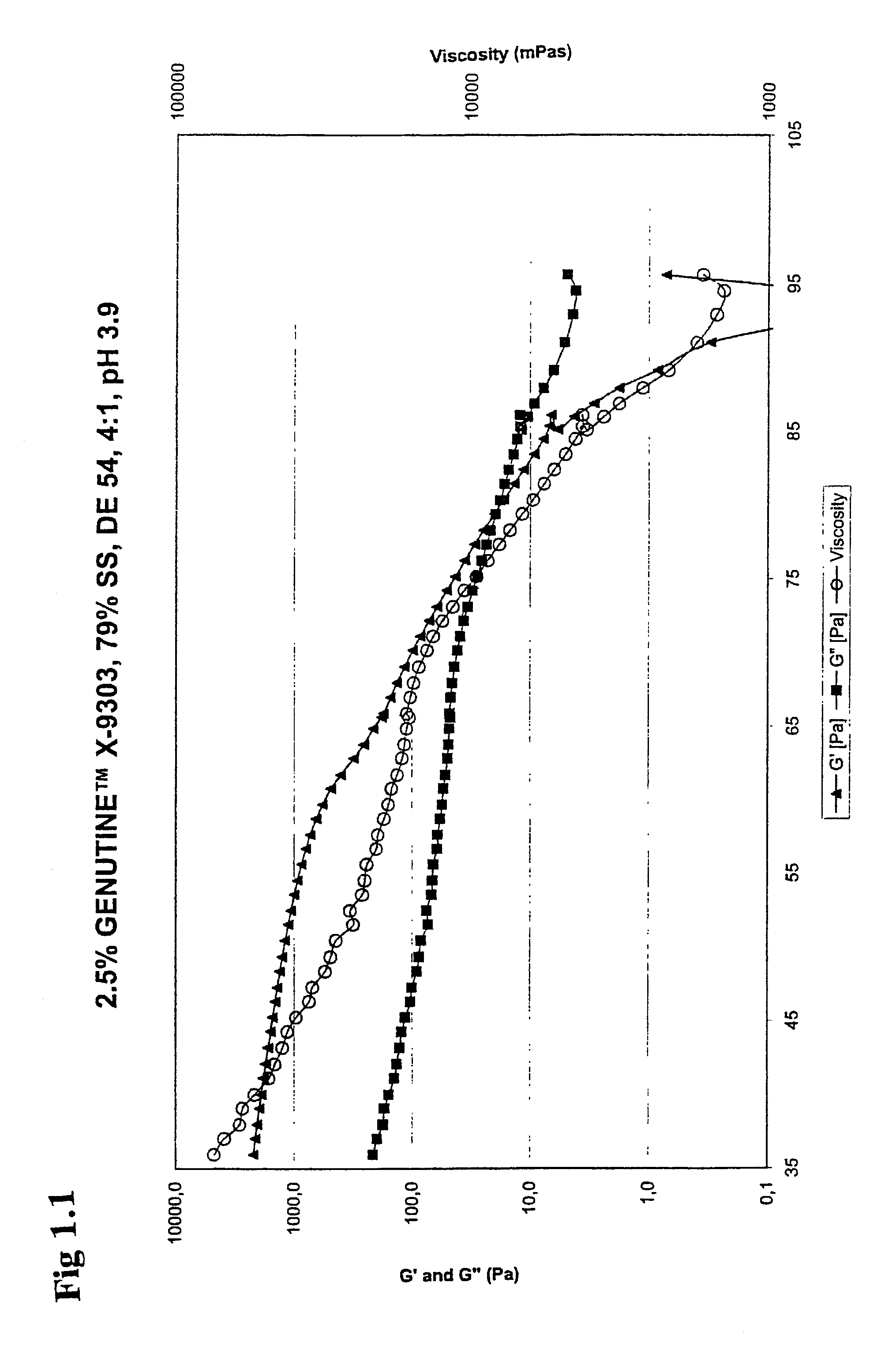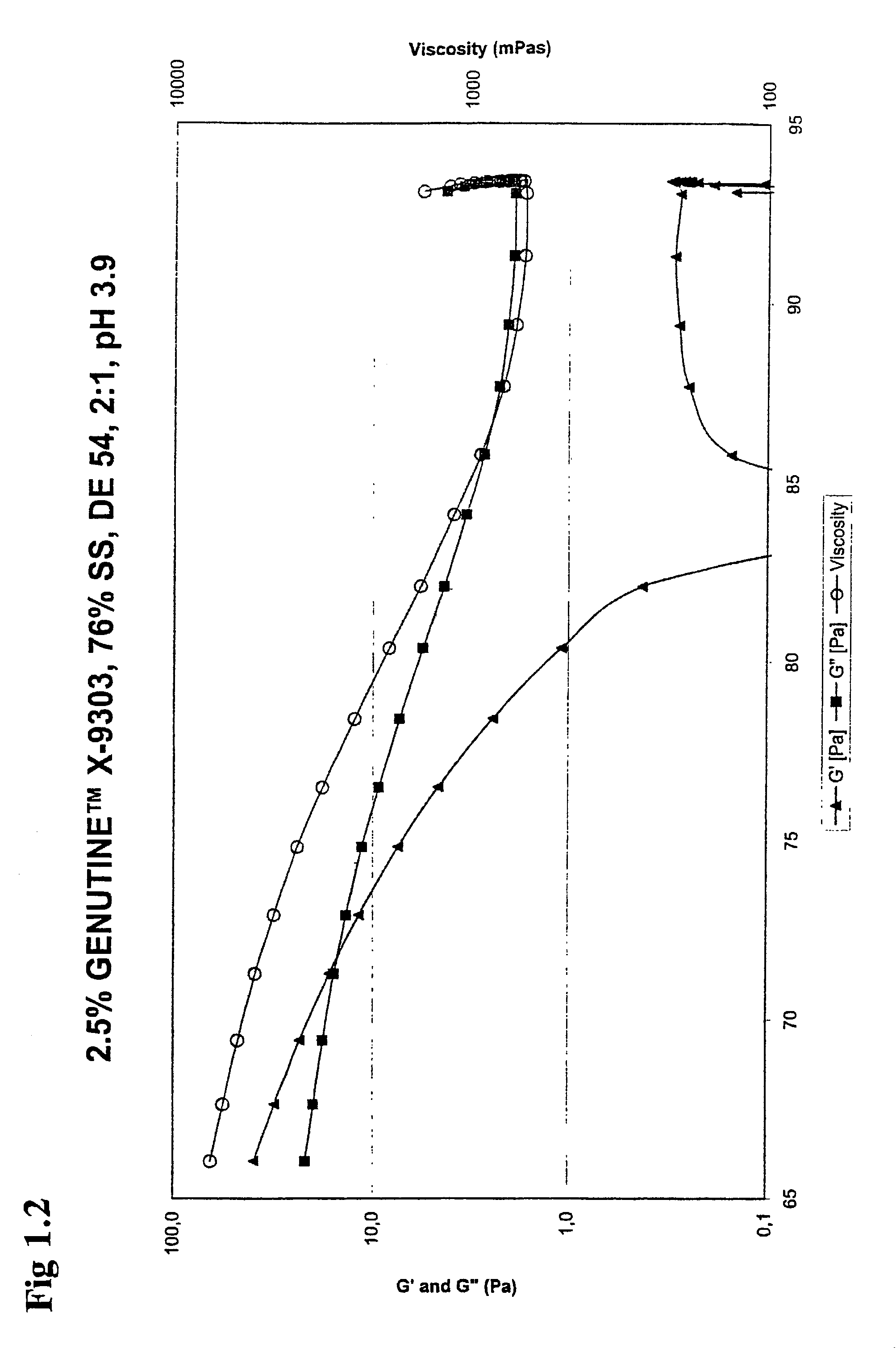Food compositions with high solids content, a method for its preparation as well as the use of carrageenans for gelling a food composition
a food composition and solids content technology, applied in confectionery, cocoa, food science and other directions, can solve the problems of inability to use gelatine in food, objectionable consumption of animals and animal-derived foods, and inability to meet the needs of muslim and jewish religious beliefs, and achieve the effect of high solids conten
- Summary
- Abstract
- Description
- Claims
- Application Information
AI Technical Summary
Benefits of technology
Problems solved by technology
Method used
Image
Examples
example 1.1
[0078]High Maltose glucose syrup (DE 54) Cargill HM 70, 80% SS, Cargill, The Netherlands.
Preparation of a Gelled Soft Candy (Wine Gums) Containing 60% SS and a Ratio of DE 40 Glucose Syrup:DE 95 Fructose Syrup:Sucrose of 27:13:60.
[0079]362.2 g of DE 40 glucose syrup and 207.8 g of DE 95 fructose syrup (components A) are heated to about 60° C. in a sauce pan. 50.0 g of iota carrageenan type X-8300 (component B) is added to the syrup while stirring with a high speed mixer.
[0080]Upon complete dispersion of the carrageenan 870.6 g of water and a buffering agent in the form of 20.8 g of tri-sodium citrate (components C) are added to the slurry which is then heated to the boiling point (100° C.) while stirring.
[0081]Thereafter 659.6 g of sucrose (component D) is added to the slurry which is then boiled (100° C.) while stirring to adjust the content of soluble solids to 60% by weight by evaporation of water.
[0082]To this slurry 40.0 g of 50% w / v citric acid (component E) is added in order ...
examples 1.2 to 4.4
[0084]Table I provides a recipe for preparing the soft candies according to examples 1.2 to 4.4. The amount of each ingredient used in the preparation of these are given in grams per 100 grams of final slurry. The method of preparation is performed analogously to Ex. 1.1.
[0085]
TABLE IIngredients added in the preparation of soft candies (wine gums) according to the examples 1.1 to 4.4Ex. 1.1Ex. 1.2ComponentIngredients% SS(g)(g) SS(g)(g) SSA40 DE syrup8418.1115.2121.3717.9595 DE fructose syrup7010.397.2712.268.58BGENUTINE ™ type X-8300 carrageenan1002.502.52.502.5CWater 1:1043.53032.440Tri-sodium citrate1001.041.041.041.04DSucrose10032.9832.9838.9338.93ECitric acid 50% w / v502.0012.001Evaporation10.5410.54Yield100100Yield soluble solids6070Ex. 2.1Ex. 2.2ComponentIngredients% SS(g)(g) SS(g)(g) SS60 DE glucose syrup8055.1344.165.0652.05BGENUTINE ™ type X-8300 carrageenan1002.502.52.502.5CWater 1:1038.52026.530Tri-sodium citrate1001.041.041.041.04DSucrose10011.3611.3613.4113.41ECitric aci...
example 6.1
Preparation of an Aerated Food Composition (Marshmallows)
[0086]Aerated confectioneries (marshmallows) were produced according to the following table:
[0087]
TABLE IIIComponentIngredients% SS(g)(g) SSAWater—16.00—Sucrose10046.0046.00Glucose syrup (DE-39)8418.0015.12Invert syrup7519.0014.25BWater—13.50—GENUTINE ™ type1001.121.12X-8300GENU ™ Agar type 900-1000.450.45A1CWater—6.50—Icing sugar1003.003.00Hyfoama ™ DSN1000.400.40DFlavour and colourOptionalEvaporation23.97Yield100.00Yield soluble solids80.34
[0088]A sugar syrup is prepared by mixing the components (A) and heating to the boiling point. Separately a dispersion of carrageenan and a further hydrocolloid in the form of GENU™ type 900-A1 agar is dispersed in 90° C. water (Component B) while stirring with a high speed mixer for two minutes. Component (B) is added to component (A) and boiled to 86% of soluble solids. Separately therefrom the ingredients of component (C) are mixed and beaten to a stiff foam.
[0089]The mixture of compone...
PUM
 Login to View More
Login to View More Abstract
Description
Claims
Application Information
 Login to View More
Login to View More - R&D
- Intellectual Property
- Life Sciences
- Materials
- Tech Scout
- Unparalleled Data Quality
- Higher Quality Content
- 60% Fewer Hallucinations
Browse by: Latest US Patents, China's latest patents, Technical Efficacy Thesaurus, Application Domain, Technology Topic, Popular Technical Reports.
© 2025 PatSnap. All rights reserved.Legal|Privacy policy|Modern Slavery Act Transparency Statement|Sitemap|About US| Contact US: help@patsnap.com



